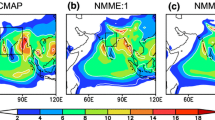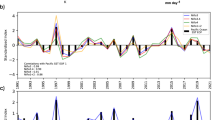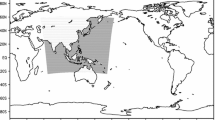Abstract
An extensive set of boreal summer seasonal hindcasts from a two tier system is compared with corresponding seasonal hindcasts from two other coupled ocean–atmosphere models for their seasonal prediction skill (for precipitation and surface temperature) of the Asian summer monsoon. The unique aspect of the two-tier system is that it is at relatively high resolution and the SST forcing is uniquely bias corrected from the multi-model averaged forecasted SST from the two coupled ocean–atmosphere models. Our analysis reveals: (a) The two-tier forecast system has seasonal prediction skill for precipitation that is comparable (over the Southeast Asian monsoon) or even higher (over the South Asian monsoon) than the coupled ocean–atmosphere. For seasonal anomalies of the surface temperature the results are more comparable across models, with all of them showing higher skill than that for precipitation. (b) Despite the improvement from the uncoupled AGCM all models in this study display a deterministic skill for seasonal precipitation anomalies over the Asian summer monsoon region to be weak. But there is useful probabilistic skill for tercile anomalies of precipitation and surface temperature that could be harvested from both the coupled and the uncoupled climate models. (c) Seasonal predictability of the South Asian summer monsoon (rainfall and temperature) does seem to stem from the remote ENSO forcing especially over the Indian monsoon region and the relatively weaker seasonal predictability in the Southeast Asian summer monsoon could be related to the comparatively weaker teleconnection with ENSO. The uncoupled AGCM with the bias corrected SST is able to leverage this teleconnection for improved seasonal prediction skill of the South Asian monsoon relative to the coupled models which display large systematic errors of the tropical SST’s.














Similar content being viewed by others
References
Saha S et al (2013) The NCEP climate forecast system Version 2. J. Climate. Submitted. Available from http://cfs.ncep.noaa.gov/cfsv2.info/CFSv2_paper.pdf
Alpert JC, Kanamitsu M, Caplan PM, Sela JG, White GH, Kalnay E (1988) Mountain induced gravity wave drag parameterization in the NMC medium-range model. Preprints, eighth conference on numerical weather prediction, Baltimore, MD. Am Meteor Soc: 726–733
Annamalai H, Liu P (2005) Response of the Asian Summer Monsoon to changes in El Niño properties. Quart J R Meteor Soc 131:805–831
Annamalai H, Hamilton K, Sperber KR (2007) The South Asian summer monsoon and its relationship with ENSO in the IPCC AR4 simulations. J Clim 20:1071–1092
Bracco A, Kucharski F, Molteni F, Hazeleger W, Severijns C (2007) A recipe for simulating the interannual variability of the Asian Summer Monsoon and its relation with ENSO. Clim Dyn 28:441–460. doi:10.1007/s00382-006-0190-0
Chou M-D, Suarez MJ (1994) An efficient thermal infrared radiation parameterization for use in general circulation models. Technical report series on global modeling and data assimilation, NASA/TM-1994-104606, vol 3, p 85
Chou M-D, Lee K-T, Tsay S-C, Fu Q (1996) Parameterization for cloud long wave scattering for use in atmospheric models. J Clim 12:159–169
Clift PD, Plumb AJ (2008) The Asian monsoon: causes, history and effects. Cambridge University Press, Cambridge
DelSole T, Shukla J (2012) Climate models produce skillful predictions of Indian summer monsoon rainfall. Geophys Res Lett 39:L09703. doi:10.1029/2012GL051279
Delworth TL, Manabe S (1988) The influence of potential evaporation on the variabilities of simulated soil wetness and climate. J Clim 1:523–547
Ding Y, Chan JCL (2005) The East Asian summer monsoon: an overview. Meteor Atm Phys 89:117–142
Ek MB, Mitchell KE, Lin Y, Rogers E, Grunmann P, Koren V, Gayno G, Tarpley JD (2003) Implementation of Noah land surface model advances in the National Centers for Environmental Prediction operational mesoscale Eta model. J Geophys Res 108:8851. doi:10.1029/2002JD003296
Gadgil S, Sajani S (1998) Monsoon precipitation in the AMIP runs. Clim Dyn 14:659–689
Goswami BN (1998) Interannual variations of Indian summer monsoon in a GCM: external conditions versus internal feedbacks. J Clim 11:501–522
Hong S-Y, Pan H-L (1996) Nonlocal boundary layer vertical diffusion in a medium-range forecast model. Mon Wea Rev 122:3–26
Jiang X, Yang S, Li Y, Kumar A, Liu X, Zuo Z, Jha B (2012) Seasonal-to-Interannual prediction of the Asian summer monsoon in the NCEP climate forecast system version 2. J Clim 26:3708–3727
Kain JS (2004) The Kain-Fritsch convective parameterization: an update. J Appl Meteor 43:170–181
Kain JS, Fritsch JM (1993) Convective parameterization for mesoscale models: the Kain-Fritsch scheme. The Representation of Cumulus convection in Numerical Models. Meteor. Monogr. No. 46, Am Meteor Soc pp 165–170
Kalnay E, Coauthors (1996) The NCEP/NCAR 40-Year reanalysis project. Bull Amer Meteor Soc 77:437–471
Kanamitsu M, Ebusuzaki W, Woollen J, Yang S-K, Hnilo J, Fiorino M, Potter GL (2002) NCEP-DOE AMIP-II reanalysis (R-2). Bull Am Meteorol Soc 83:1631–1643
Kang I-S et al (2002) Intercomparison of the climatological variations of Asian summer monsoon precipitation simulated by 10 GCMs. Clim Dyn. doi:10.1007/s00382-002-0245-9
Kim H-M, Webster PJ, Curry JA, Toma VE (2012) Asian summer monsoon prediction in ECMWF system 4 and NCEP CFSv2 retrospective seasonal forecasts. Clim Dyn. doi:10.1007/s00382-012-1470-5
Kirtman BP, Min D (2009) Multimodel ensemble ENSO prediction with CCSM and CFS. Monthly Weather Rev 137:2908–2930
Kirtman BP, Shukla J (2002) Interactive coupled ensemble: a new coupling strategy for CGCMs. Geophys Res Lett. doi:10.1029/2002GL014834
Koster RD et al (2004) Regions of strong coupling between soil moisture and precipitation. Science 305:1138–1140
Krishnakumar K, Rajagopalan B, Cane MA (1999) On the weakening relationship between Indian monsoon and ENSO. Science 284:2156–2159
Krishnamurthy V, Goswami BN (2000) Indian Monsoon–ENSO relationship on interdecadal timescale. J Clim 13:579–595
Krishnamurti TN, Ramanathan Y (1982) Sensitivity of the monsoon onset to differential heating. J Atmos Sci 39:1290–1306
Kucharski F, Bracco A, Yoo JH, Molteni F (2007) Low-frequency variability of the Indian Monsoon–ENSO relationship and the Tropical Atlantic: the “Weakening” of the 1980s and 1990s. J Clim 20:4255–4266
LaRow T (2013) The impact of SST bias correction on North Atlantic Hurricane Retrospective Forecasts. Mon Wea Rev 141:490–498
Li H, Misra V (2013) Global seasonal climate predictability in a two tiered forecast system. Part II: boreal winter and spring seasons. Clim Dyn. doi:10.1007/s00382-013-1813-x
Mason SJ, Graham NE (1999) Conditional probabilities, relative operating characteristics, and relative operating levels. Weather Forecast 14:713–725
Mason SJ, Graham NE (2002) Areas beneath the relative operating characteristics (ROC) and levels (RROL) curves: statistical significance and interpretations. Quart J R Meteoro Soc 128:2145–2166
Meehl GA, Arblaster JM (2002) Indian monsoon GCM sensitivity experiments testing tropospheric biennial oscillation transition conditions. J Clim 15:923–944
Misra V (2008) Coupled interactions of the monsoons. Geophys Res Lett 35:1–7
Misra V, Li H, Wu Z, DiNapoli S (2013) Global seasonal climate predictability in a two tiered forecast system. Part I: Boreal summer and fall seasons. Clim Dyn. doi:10.1007/s00382-013-1812-y
Mitchell TD, Jones PD (2005) An improved method of constructing a database of monthly climate observations and associated high resolution grids. Int J Climatol 25:693–712
Palmer TN (1994) Chaos and predictability in forecasting the monsoons. Proc Indian Natl Sci Acad 60A:57–66
Saha S, Moorthi S, Wu X, Wang J, Nadiga S, Tripp P, Pan H-L, Behringer D, Hou Y-T, Chuang H, Iredell M, Michael Ek, Meng J, Yang R, van den Dool H, Zhang Q, Wang W, Chen M (2012) The NCEP Climate Forecast System Version 2. (Submitted to the Journal of Climate.) Available from http://cfs.ncep.noaa.gov/cfsv2.info/CFSv2_paper.pdf
Shukla J, Paolino DA (1983) The Southern Oscillation and longrange forecasting of the summer monsoon rainfall over India. Mon Wea Rev 111:1830–1837
Sikka DR (1980) Some aspects of the large-scale fluctuations of summer monsoon rainfall over India in relation to fluctuations in the planetary and regional scale circulation parameters. Proc Indian Natl Acad Sci 89:179–195
Slingo JM (1987) The development and verification of a cloud prediction model for the ECMWF model. Quart J R Meteor Soc 113:899–927
Sperber KR, Palmer TN (1996) Interannual tropical rainfall variability in general circulation model simulations associated with the Atmospheric Model Intercomparison Project. J Clim 9:2727–2750
Sperber KR et al (2001) Dynamical seasonal predictability of the Asian summer monsoon. Mon Wea Rev 129:2226–2248
Straus D, Shukla J (2002) Does ENSO force the PNA? J Clim 15:2340–2358
Tao S, Chen L (1987) A review of recent research on the East Asian summer monsoon. In: Chang C-P, Krishnamurti TN (eds) China, Monsoon meteorology. Oxford University Press, Oxford, pp 60–92
Tiedtke M (1983) The sensitivity of the time-mean large-scale flow to cumulus convection in the ECWMF model. In: Proceedings of ECMWF workshop on convection in large-scale models. European Centre for Medium-Range Forecasts, Reading, United Kingdom, pp 297–316
Trenberth KE, Hurrell JW, Stepanaik DP (2006) The Asian Monsoon: global perspectives. In: Wang B (ed) The Asian Monsoon. Springer/Praxis Publishing Co, New York, pp 67–87
Waliser DE et al (2002) AGCM simulations of intraseasonal variability associated with the Asian summer monsoon. Clim Dyn 21:423–446
Walker GT, Bliss EW (1932) World Weather V. Mem Roy Meteor Soc 4:53–84
Wang B, J-Y Lee et al (1980–2004) Advance and prospect of seasonal prediction: assessment of the APCC/CliPAS 14-model ensemble retroperspective seasonal prediction (1980–2004). Clim Dyn 33: 90. doi:10.1007/s00382-008-0460-0
Wang B, Fan Z (1999) Choice of South Asian Summer Monsoon Indices. Bull Am Meteor Sci 80:629–638
Wang B, Clemens S, Liu P (2003) Contrasting the Indian and East Asian monsoons: implications on geologic time scale. Mar Geol 201:5–21
Wang B, Kang IS, Lee JY (2004) Ensemble simulations of Asian-Australian Monsoon Variability by 11 AGCMs. J Clim 17:803–818
Wang B et al (2005a) Fundamental challenge in simulation and prediction of summer monsoon rainfall. Geophys Res Lett 32:L15711. doi:10.1029/2005GL022734
Wang B, Ding Q, Kang I-S et al (2005b) Fundamental challenges in simulation and prediction of summer monsoon rainfall. Geophys Res Lett 32(15):L15711
Wang B, Lee JY, Kang IS, Shukla J, Kug JS, Kumar A, Schemm J, Luo JJ, Yamagata T, Park CK (2008a) How accurately do coupled climate models predict the leading modes of Asian-Australian interannual variability? Clim Dyn 30:605–619
Wang B et al (2008b) Advance and prospectus of seasonal prediction: assessment of the APCC/CliPAS 14-model ensemble retrospective seasonal prediction (1980–2004). Clim Dyn. doi:10.1007/s00382-008-0460-0
Wang B, Ding Q, Joseph V (2009) Objective definition of the Indian Summer Monsoon onset using large scale winds. J Clim 22:3303–3316
Webster PJ (2006) The coupled monsoon system. In: Wang B (ed) The Asian Monsoon. Praxis, pp 1–66
Webster PJ, Magana VO, Palmer TN, Shukla J, Tomas RA, Yanai M, Yasunari T (1998) Monsoons: processes, predictability, and the prospects for prediction. J Geophys Res 103:14451–14510
Wu R, Kirtman BP (2005) Role of Indian and Pacific Ocean air-sea coupling in tropical atmospheric variability. Clim Dyn 25:155–170
Xie P, Arkin PA (1997) Global precipitation: a 17-year monthly analysis based on gauge observations, satellite estimates, and numerical model outputs. Bull Amer Meteorol Soc 78:2539–2558
Zhou T, Wu B, Wang B (2009) How well do atmospheric general circulation models capture the leading modes of the interannual variability of the Asian–Australian Monsoon? J Climate 22:1159–1173
Acknowledgments
This work was supported by grants from NOAA (NA12OAR4310078, NA10OAR4310215, NA11OAR4310110), USGS (06HQGR0125), and USDA (027865). All model integrations for this paper were done on the computational resources provided by the Extreme Science and Engineering Discovery Environment (XSEDE) under TG-ATM120017 and TG-ATM120010. The University of Delaware precipitation data was provided by the NOAA/OAR/ESRL PSD, Boulder, Colorado, USA, from their Web site at http://www.esrl.noaa.gov/psd/.
Author information
Authors and Affiliations
Corresponding author
Appendix: Signal to noise ratio
Appendix: Signal to noise ratio
The signal to noise ratio is an objective measure of an AGCM’s predictability (Straus and Shukla 2000). It is basically a measure of the variance displayed by the ensemble mean relative to the ensemble spread of the seasonal hindcast. So higher values of this ratio correspond to higher predictability of the phenomenon by the AGCM. This measure of predictability however does not reflect on the verification of the hindcast or forecast. The ensemble mean for a given climate variable (say Y), for a given climate model, and for a given year j is:
where i is the index for number of ensemble members and K is the total number of ensemble members (in our study it is 6).
The variance of the ensemble spread for a given year j is given by:
The variance of the ensemble spread is a measure of the noise in the forecast system, which is averaged over all years of the hindcast to obtain:
The variance of the signal component is given by:
where
Then, predictability (Π) or signal to noise ratio is defined as:
Rights and permissions
About this article
Cite this article
Misra, V., Li, H. The seasonal predictability of the Asian summer monsoon in a two-tiered forecast system. Clim Dyn 42, 2491–2507 (2014). https://doi.org/10.1007/s00382-013-1838-1
Received:
Accepted:
Published:
Issue Date:
DOI: https://doi.org/10.1007/s00382-013-1838-1




